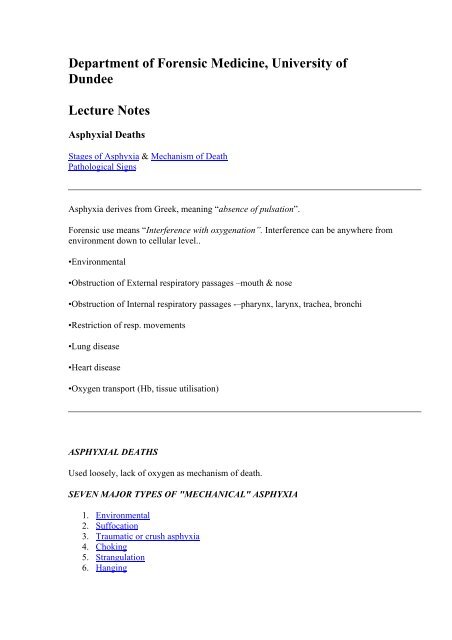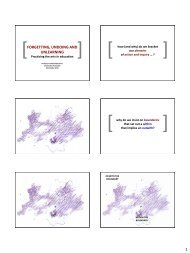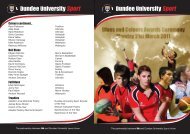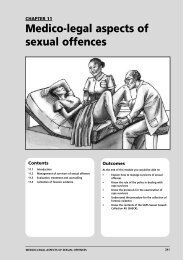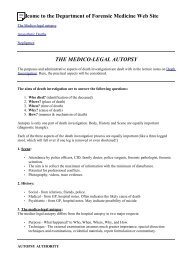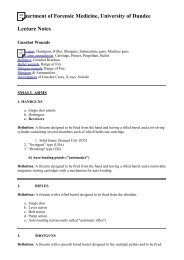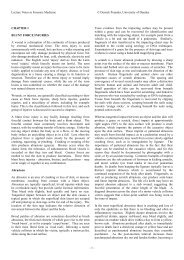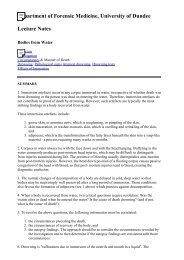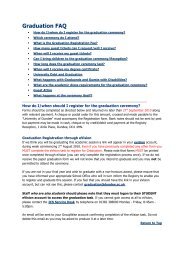Asphyxial Deaths - University of Dundee
Asphyxial Deaths - University of Dundee
Asphyxial Deaths - University of Dundee
Create successful ePaper yourself
Turn your PDF publications into a flip-book with our unique Google optimized e-Paper software.
Department <strong>of</strong> Forensic Medicine, <strong>University</strong> <strong>of</strong><br />
<strong>Dundee</strong><br />
Lecture Notes<br />
<strong>Asphyxial</strong> <strong>Deaths</strong><br />
Stages <strong>of</strong> Asphyxia & Mechanism <strong>of</strong> Death<br />
Pathological Signs<br />
Asphyxia derives from Greek, meaning “absence <strong>of</strong> pulsation”.<br />
Forensic use means “Interference with oxygenation”. Interference can be anywhere from<br />
environment down to cellular level..<br />
•Environmental<br />
•Obstruction <strong>of</strong> External respiratory passages –mouth & nose<br />
•Obstruction <strong>of</strong> Internal respiratory passages -–pharynx, larynx, trachea, bronchi<br />
•Restriction <strong>of</strong> resp. movements<br />
•Lung disease<br />
•Heart disease<br />
•Oxygen transport (Hb, tissue utilisation)<br />
ASPHYXIAL DEATHS<br />
Used loosely, lack <strong>of</strong> oxygen as mechanism <strong>of</strong> death.<br />
SEVEN MAJOR TYPES OF "MECHANICAL" ASPHYXIA<br />
1. Environmental<br />
2. Suffocation<br />
3. Traumatic or crush asphyxia<br />
4. Choking<br />
5. Strangulation<br />
6. Hanging
7. Inhalation<br />
STAGES OF ASPHYXIA<br />
1. Struggle - forceful breathing<br />
2. Quiescence - unconscious, lifeless<br />
3. Convulsions - disturbs scene, incontinence<br />
4. Apnea - lifeless, weak pulse.<br />
MECHANISM OF DEATH<br />
• Complex<br />
• Oxygen deprivation<br />
• Carbon dioxide accumulation<br />
• Reduced blood flow to brain (neck pressure)<br />
• Vagal inhibition (classic defence).<br />
PATHOLOGICAL CHANGES<br />
1. General - cyanosis, congestion, petechial haemorrhages, oedema.<br />
2. Specific - reflects type <strong>of</strong> mechanical asphyxia.<br />
GENERAL SIGNS<br />
1. Cyanosis - plum colour<br />
2. Congestion - face<br />
3. Petechial haemorrhages<br />
- pinpoint (less than 1 mm)<br />
- eyelids, conjunctivae, lips, ears, face, neck, upper chest<br />
- distribution <strong>of</strong> diagnostic importance<br />
- post mortem petechial haemorrhages in livid areas<br />
4. Oedema - face, tongue, larynx.<br />
INJURIES TO THE LARYNX<br />
1. Hyoid bone<br />
- horseshoe shaped, curve to the front - greater horns fractured by squeezing or<br />
downward traction.<br />
2. Thyroid cartilage<br />
- Adam's apple
- two plates, midline ridge, notch<br />
- superior horns fractured by squeezing<br />
3. Cricoid cartilage<br />
- signet ring shaped<br />
- fracture uncommon, direct blow<br />
4. Carotid artery<br />
- main blood supply to brain<br />
- divides adjacent to superior horn <strong>of</strong> thyroid cartilage<br />
- sudden loss <strong>of</strong> consciousness<br />
5. Vagus nerve<br />
- alongside carotid artery<br />
- innervates heart<br />
- sudden death from reflex vagal inhibition<br />
1.ENVIRONMENTAL ASPHYXIATION<br />
• Low or no atmospheric oxygen<br />
• Ships' holds, scuba diving, surgical anaesthesia, disused refrigerators<br />
• Toxicological studies no value<br />
• Circumstances <strong>of</strong> death.<br />
3. SUFFOCATION<br />
“Suffocation” is <strong>of</strong>ten used as a general term for deprivation <strong>of</strong> O2, due to lack <strong>of</strong> it in the<br />
environment or external obstruction <strong>of</strong> airways<br />
• Obstruction <strong>of</strong> nose and mouth<br />
• Homicidal, s<strong>of</strong>t smothering<br />
• "Overlying"<br />
• Plastic bags, suicidal or accidental<br />
• Difficult diagnosis; history and scene.<br />
3. TRAUMATIC OR CRUSH ASPHYXIA<br />
• Pressure fixation <strong>of</strong> chest wall and abdomen<br />
• Trench collapse, pinned under vehicle, crowd collapse<br />
• Florid asphyxial signs<br />
• "Pressing", "burking".<br />
4. CHOKING<br />
• Obstruction <strong>of</strong> upper airway or glottis<br />
• Gag, homicide, rarely suicide<br />
• Accidental in elderly, mental defectives, children
• "Cafe Coronary".<br />
5. STRANGULATION<br />
- Airway obstruction at larynx from hand pressure or hand held ligature.<br />
(i) STRANGULATION BY LIGATURE<br />
• Tied, held, removed; sexual assault<br />
• Horizontal groove, uniform depth, imprint abrasion<br />
• Bruises, abrasions<br />
• Neck muscle haemorrhages, thyroid fractures<br />
• Suicide uncommon, accident occasional<br />
(ii) MANUAL STRANGULATION (THROTTLING)<br />
• Different grips, different patterns<br />
• Finger pad bruises, crescent abrasions<br />
• Neck muscle haemorrhages, hyoid and thyroid fractures<br />
• Mugging, sleeper hold<br />
• Grip for half a minute.<br />
6. HANGING<br />
• Body partly/completely suspended by ligature around neck<br />
• Brown leathery ligature furrow, imprint abrasion<br />
• Fixed noose - inverted V-shape, knot mark<br />
• Running noose - horizontal<br />
• Low suspension point - groove less marked, lower, horizontal<br />
• Typically no classic asphyxial features<br />
• Scene shows preparation and precautions.<br />
SEXUAL ASPHYXIAS<br />
• Accidental hangings, failure <strong>of</strong> safety mechanisms<br />
• Male, trasvestism or nudity, masochism, pornographic material<br />
• Scene is diagnostic.<br />
7. INHALATION<br />
• Foreign bodies or vomitus, airways below larynx<br />
• Children, accidental<br />
• Gastric contents, contentious
• See drowning<br />
8. POSITIONAL ASPHYXIA<br />
• Bodily position which obstructs airway or impairs act <strong>of</strong> breathing<br />
Typically ass. with sedative intoxication<br />
Usually accidental (alcoholics)<br />
• Restraint asphyxia is a variant in which chest, diaphragm & accessory<br />
muscles are impaired by the act <strong>of</strong> physical restraint<br />
Typically ass. with stimulant intoxication<br />
Common in psychiatric & custody situations<br />
Reference: A. Morrison & D.Sadler. Death <strong>of</strong> a Psychiatric Patient During Physical<br />
Restraint. Excited Delerium – A Case Report. Medicne, Science & the Law 2001. 41<br />
(1): 46-50


